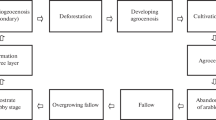Abstract
It is shown that the horizons and profiles of anthropogenically transformed soils of podzolic type—light typical agrozems, typical texture-differentiated soils developed from glaciolacustrine loamy sands and clays and from noncalcareous mantle loams, agrosoddy deeply podzolic soils developed from noncalcareous mantle loams, and agrosoddy shallow-podzolic soils developed from noncalcareous mantle loams and from calcareous loams underlain by ancient glaciolacustrine loams and clays—are characterized by some anisotropy of most of their properties. The highest anisotropy is typical of the field water content, bulk density, and total porosity. The coefficients of anisotropy (gradients) calculated for the separate horizons as the ratios between the values of the properties measured in the horizontal and vertical directions (k = Phoriz/Pvertic) of these properties are much higher than those of other soil properties. The coefficient of anisotropy of the soil profile (K) is suggested as the coefficient of correlation between the values of a given property determined in the horizontal and vertical soil sections. For the considered properties, K varies from 0.4 to 0.6. For other soils properties, such as the solid phase density, the electrical resistance determined in a laboratory and in the field, and the organic carbon content, the coefficients of anisotropy are close to 1.0. The clay content has an intermediate anisotropy. The values of anisotropy and its direction (gradient) should be taken into account upon the assessment of the soil physical properties and the processes controlling them; this is particularly important in the study of soil transformation. The revealed regularities of the soil anisotropy make it possible to suggest a new interpretation of the data on the distribution of water and energy in soil profiles.
Similar content being viewed by others
References
L. O. Karpachevskii, P. V. Kuznetsov, D. E. Mokrushina, and T. A. Zubkova, “Anisotropy in Sandy Forest Soils,” Pochvovedenie, No. 6, 638–645 (2001) [Eur. Soil Sci. 34 (6), 569–576 (2001)].
Classification and Diagnostic System of Russian Soils (Oikumena, Smolensk, 2004), 342 pp. [in Russian].
A. I. Pozdnyakov, Field Electrophysics of Soils (Nauka, Moscow, 2001), 188 pp. [in Russian].
A. V. Rusakov, “Reconstruction of the Evolution of Landscapes in the Upper Volga Basin during the Late Pleistocene on the Basis of Soil Studies,” in Eco-Biological Problems of the Caspian Sea Basin and Closed Drainage Areas of Eurasia, Materials of the X Intern. Conf. Devoted to the 450th Anniversary of Astrakhan, April 25–30, 1980 (Astrakhan, 2008), pp. 366–368 [in Russian].
A. V. Rusakov and M. A. Korkka, “New Data on the Middle Valdai Paleosols in the Periglacial Zone of the Russian Plain and Problems of Landscape Evolution,” in Materials of the V Congr. of the Dokuchaev Soil Sci. Soc., Rostov-on-Don, August 18–23, 2008, p. 335 [in Russian].
A. V. Rusakov, A. I. Pozdnyakov, and A. D. Pozdnyakova, “Catenary Differentiation of Soils of the Klin-Dmitrov Ridge and the Adjacent Upper Volga Lowland: Problems of Paleogeography of Landscapes and Agricultural Development of the Territory,” in Problems of Ancient Farming and Soil Evolution in Forest and Steppe Landscapes of Europe, Materials of the Intern. Workshop, Belgorod, October 19–21, 2006, p. 62–68 [in Russian].
A. B. Umarova, E. V. Shein, I. V. Sokolova, and A. S. Landysheva, “Preferential Water Flows as One of the Factors of Preservation of the Spatial Heterogeneity of the Soil Cover,” in Ecology of Biosystems: Problems of Study, Indication, and Forecasting, Materials of the Sci. Conf. Devoted to the 75th Anniversary of Astrakhan State Univ. (Izdat. Dom “Astrakhanskii Univ.”, Astrakhan, 2007), Vol. 1, pp. 180–181 [in Russian].
A. B. Umarova and P. I. Kirdyashkin, “Spatial-Temporal Patterns of Water Migration in Complex Soilscapes of Vladimir Opolie,” in Spatial-Temporal Organization of the Soil Cover: Theoretical and Applied Aspects, Materials of the Intern. Sci. Conf., March 1—3, 2007 (Izdat. Dom “S.-Peterb. Gos. Univ., St. Petersburg, 2007), pp. 355–358 [in Russian].
A. B. Umarova and E. V. Shein, “The Concept of Soil Profile as a Natural Body with Characteristic Properties in Each Layer and with Upper and Lower Boundary Conditions,” Problems of the History, Methodology, and Philosophy of Soil Science, Materials of the II National Conf. with Intern. Participation, Pushchino, November 5–9, 2007 (OOO Foton-vek, 2007), Vol. 2, pp. 140–144.
Author information
Authors and Affiliations
Corresponding author
Additional information
Original Russian Text © A.I. Pozdnyakov, A.V. Rusakov, S.M. Shalaginova, A.D. Pozdnyakova, 2009, published in Pochvovedenie, 2009, No. 11, pp. 1308–1319.
Rights and permissions
About this article
Cite this article
Pozdnyakov, A.I., Rusakov, A.V., Shalaginova, S.M. et al. Anisotropy of the properties of some anthropogenically transformed soils of podzolic type. Eurasian Soil Sc. 42, 1218–1228 (2009). https://doi.org/10.1134/S1064229309110039
Received:
Published:
Issue Date:
DOI: https://doi.org/10.1134/S1064229309110039




